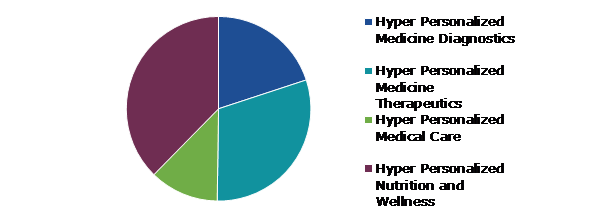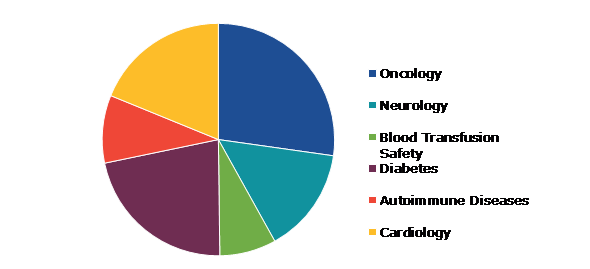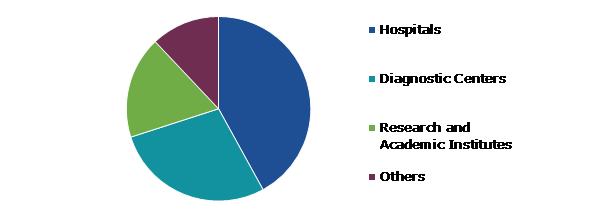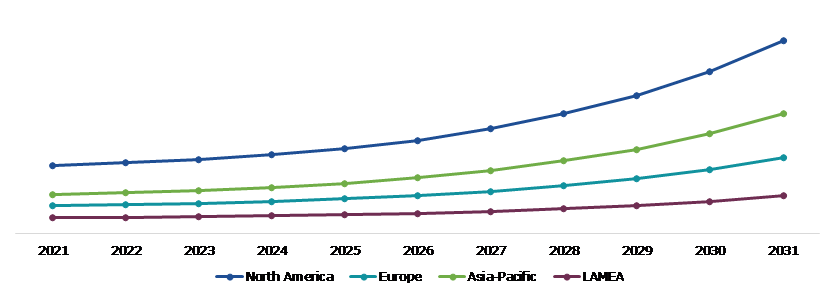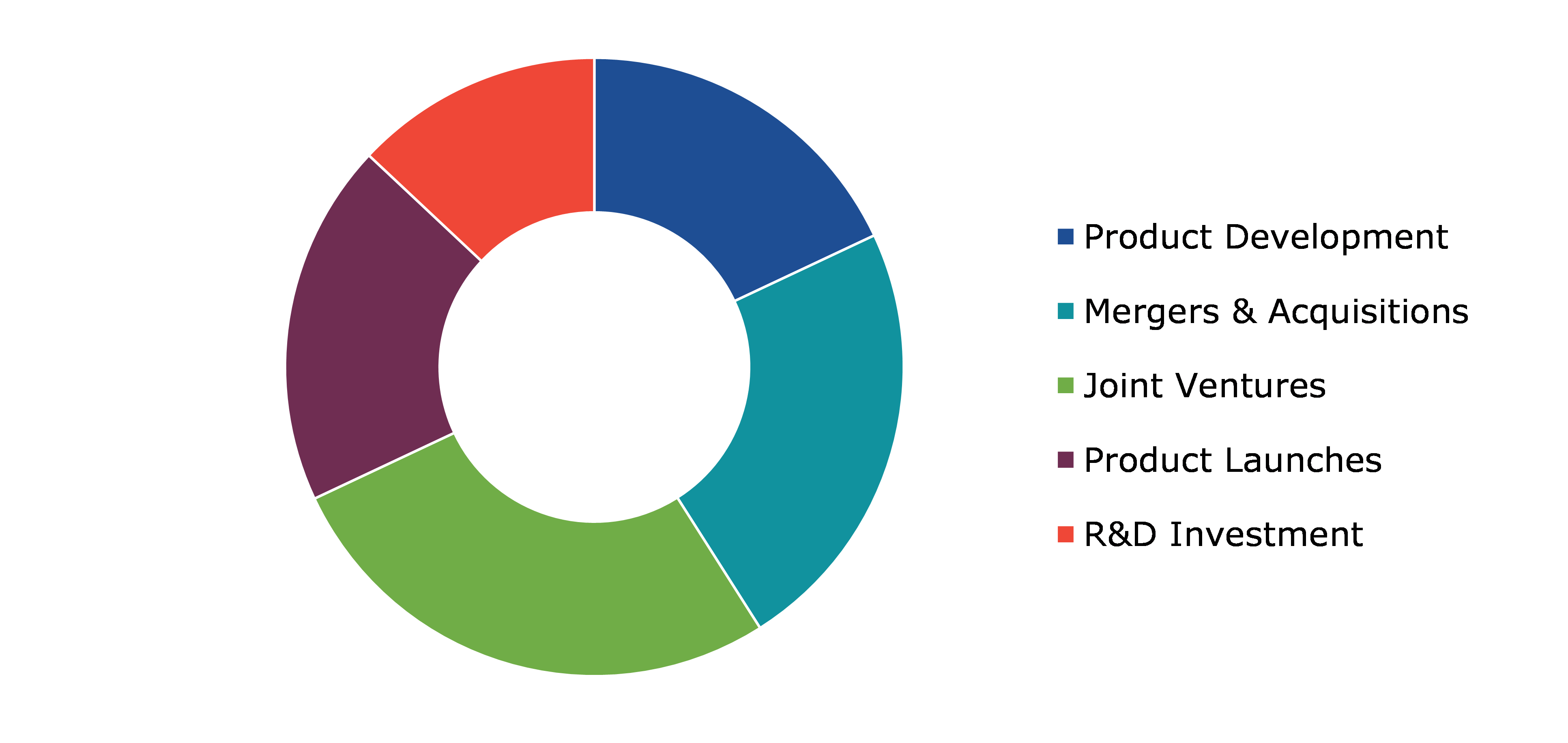Hyper-Personalized Medicine Market Report
RA08652
Hyper-Personalized Medicine Market by Product (Hyper Personalized Medicine Diagnostics, Hyper Personalized Medicine Therapeutics, Hyper Personalized Medical Care, and Hyper Personalized Nutrition and Wellness), Application (Oncology, Neurology, Blood Transfusion Safety, Diabetes, Autoimmune Diseases, and Cardiology), End User (Hospitals, Diagnostic Centers, Research and Academic Institutes, and Others), and Regional Analysis (North America, Europe, Asia-Pacific, and LAMEA): Global Opportunity Analysis and Industry Forecast, 2022-2031
Global Hyper-Personalized Medicine Market Analysis
The Global Hyper-Personalized Medicine Market Size was $2,100.00 billion in 2021 and is predicted to grow with a CAGR of 11.7%, by generating a revenue of $5,886.50 billion by 2031.
Global Hyper-Personalized Medicine Market Synopsis
The development of patient-specific, targeted, and customized treatments offered to people based on more than just diagnosis is referred to as hyper-personalized medicine. The increase in demand for personalized treatments, advancements in technologies, rise in the prevalence of chronic diseases, and the support of regulatory bodies and healthcare systems are the primary drivers expected to boost the hyper-personalized medicine industry demand in the upcoming years.
However, limited data availability is one of the potential disadvantages of hyper-personalized medicine. The success of hyper-personalized medicine relies heavily on the availability of vast amounts of data on individual patients, including their genetic makeup, medical history, lifestyle factors, and other relevant information. The availability of data is limited, particularly for rare diseases and conditions. This limitation can slow down the progress of hyper-personalized medicine development and hinder the ability to provide targeted treatments for patients with rare diseases. This factor is projected to hamper the market revenue growth during the forecast period.
The hyper-personalized medicine can help pharmaceutical companies to design more targeted clinical trials and develop drugs that are more effective for a specific patient population. This approach can significantly reduce the risk of drug failure and enhance the speed of drug development. By focusing on the specific needs of individual patients, hyper-personalized medicine can also help to reduce the incidence of adverse drug reactions, improving patient safety and reducing healthcare costs. Furthermore, hyper-personalized medicine can provide a significant boost to the healthcare industry by facilitating the development of innovative and effective treatment options. All these are the major factors predicted to create several growth opportunities for the key players operating in the market in the upcoming years.
According to regional analysis, the North America hyper-personalized medicine market accounted for the largest market share in 2021. The region has a large patient population, which provides a significant market for personalized medicine products and services. The increase in the prevalence of chronic diseases, such as cancer, diabetes, and cardiovascular diseases, has also driven the demand for hyper-personalized treatments that can address individual patient needs.
Hyper-Personalized Medicine Overview
Hyper-personalized medicine is an approach to healthcare that seeks to customize medical treatment to an individual's unique genetic, environmental, and lifestyle factors. It is based on the idea that each person's health is influenced by a complex set of unique factors, and that by understanding these factors, healthcare providers can provide more effective and targeted treatment. Hyper-personalized medicine has the potential to revolutionize the way healthcare is delivered, making treatments more effective, efficient, and personalized to individual patients. Hyper-personalized medicine represents a promising new approach to healthcare that has the potential to improve outcomes and reduce costs but will require careful consideration and management to ensure its benefits are realized while minimizing potential risks and challenges.
COVID-19 Impact on Global Hyper-Personalized Medicine Market
The COVID-19 pandemic has had a moderate impact on the hyper-personalized medicine market. On the contrary, COVID-19 has increased the demand for personalized medicine solutions, as patients and healthcare providers seek more targeted treatments and diagnostics for COVID-19. This has led to a surge in R&D of personalized medicine approaches to COVID-19, such as the development of vaccines that can be personalized to individual immune systems.
The hyper-personalized medicine market involves the use of advanced technologies such as genomics, proteomics, and digital health to tailor medical treatments to individual patients based on their genetic makeup, lifestyle, and health history. This approach aims to improve patient outcomes and reduce healthcare costs. The pandemic disrupted supply chains, slowed down clinical trials, and reduced healthcare budgets, all of which impede the growth of the hyper-personalized medicine market. In addition, the pandemic has highlighted health disparities and inequities, which are expected to impact the adoption of personalized medicine solutions by underserved populations.
Furthermore, while the COVID-19 pandemic has both positive and negative effects on the hyper-personalized medicine market, the overall long-term impact of hyper-personized medicine in COVID-19 treatment remains uncertain. However, personalized medicine solutions will likely continue to play a critical role in the fight against COVID-19 and other diseases in the future.
Emerging Trends and Technologies in Hyper-Personalized Medicine to Boost the Market Growth
Hyper-personalized medicine is supported by multiple technologies that are becoming increasingly integrated into the development of patient-specific, customized, and targeted treatments for people based on the diagnosis. For instance, advances in genomics technology have made it possible to identify specific genetic markers associated with various diseases. These advancements have opened up new opportunities for hyper-personalized medicine, which aims to deliver individualized treatments based on a patient's unique genetic profile. This approach allows for more precise diagnosis and treatment, resulting in improved patient outcomes and reduced healthcare costs.
Furthermore, the availability of genomic data and the ability to analyze it in real time has enabled the development of predictive models that can identify individuals at risk of developing certain diseases. This allows for earlier interventions and preventative measures, leading to better health outcomes. Moreover, the advancements in genomics technology are expected to play a significant role in driving the hyper-personalized medicine market growth in the upcoming years.
To know more about global hyper-personalized medicine market drivers, get in touch with our analysts here.
High Cost of Hyper-personalized Medicines to Restrain the Market Growth
The cost of genetic testing, for example, can be prohibitively expensive for some patients. Developing personalized treatments that are designed to an individual's unique genetic profile requires extensive R&D, which can be expensive. In addition, insurance companies may be hesitant to cover the cost of hyper-personalized treatments, especially if they are experimental or not yet proven to be effective. This could limit the availability of these treatments to only the wealthiest individuals. The high cost of hyper-personalized medicine could also lead to a shift in healthcare priorities, with more resources being allocated towards developing and providing these treatments instead of focusing on more affordable and accessible preventative measures or treatments. These factors are anticipated to hamper the hyper-personalized medicine market share in the upcoming years.
Increase in Demand for Hyper-Personalized Medicines to Create Excellent Opportunities in the Market
Hyper-personalized medicines can also help accelerate drug development by identifying patient subgroups that may respond better to certain drugs. This can help pharmaceutical companies design more targeted clinical trials and develop drugs that are more effective for specific patient populations. Hyper-personalized medicine has the potential to revolutionize the drug development process by enabling the identification of patient-specific treatment options. It can help accelerate the drug development process by enabling researchers to identify patient subgroups that may respond better to certain drugs, reducing the need for large, time-consuming clinical trials. All these factors together highlight the immense potential of hyper-personalized medicine to transform the drug development process and bring about more effective treatments for patients, which is anticipated to boost market growth in the future.
To know more about global hyper-personalized medicine market opportunities, get in touch with our analysts here.
Global Hyper-Personalized Medicine Market, by Product
Based on product, the market has been divided into hyper-personalized medicine diagnostics, hyper-personalized medicine therapeutics, hyper-personalized medical care, and hyper-personalized nutrition and wellness. Among these, the hyper-personalized nutrition and wellness sub-segment accounted for the highest market share in 2021, whereas the hyper-personalized medicine therapeutics sub-segment is estimated to show the fastest growth during the forecast period.
Global Hyper-Personalized Medicine Market Size, by Product, 2021
Source: Research Dive Analysis
The hyper-personalized nutrition and wellness sub-segment accounted for the largest market share in 2021. Hyper-personalized nutrition and wellness is a growing segment in the hyper-personalized medicine market as the development of technologies like artificial intelligence (AI) and machine learning has made it possible to analyze large amounts of data to personalize nutrition and wellness plans for individuals. This has led to the creation of apps and other digital tools that use data from wearables, genetic testing, and other sources to provide personalized recommendations. As more individuals use wearables, genetic testing, and other health-tracking tools, there is an increase in the amount of data available to personalize nutrition and wellness plans. This data can be analyzed to identify patterns and develop personalized recommendations.
The hyper-personalized medicine therapeutics sub-segment is anticipated to show the fastest growth in 2031. The hyper-personalized therapeutics medicine market can be attributed to the growing demand for targeted and precise treatments based on individual genetic, molecular, and clinical characteristics. Advances in genomics, proteomics, and other omics technologies, along with the integration of artificial intelligence and machine learning algorithms, have facilitated the identification of personalized biomarkers, drug targets, and treatment regimens that can enhance efficacy, safety, and patient outcomes. The increase in the prevalence of chronic diseases, the rise in healthcare costs, and the need for more sustainable and affordable healthcare solutions have also driven the adoption of hyper-personalized medicine approaches.
Global Hyper-Personalized Medicine Market, by Application
Based on application, the market has been divided into oncology, neurology, blood transfusion safety, diabetes, autoimmune diseases, and cardiology. Among these, the oncology sub-segment accounted for the highest revenue share in 2021.
Global Hyper-personalized Medicine Market Share, by Application, 2021
Source: Research Dive Analysis
The oncology sub-segment accounted for the largest market share in 2021, owing to the increase in the prevalence of cancer and the need for more effective treatments. The rising global prevalence of cancer has increased the demand for more tailored treatments that can address the specific needs of individual patients. Hyper-personalized medicine presents a possible option in this area, as it enables healthcare practitioners to tailor therapies to the individual genetic profiles of patients. Therefore, the oncology sub-segment is likely to maintain its position in the hyper-personalized medicine market. These factors are anticipated to boost the growth of the oncology sub-segment during the forecast timeframe.
Global Hyper-Personalized Medicine Market, by End User
Based on end user, the market has been divided into hospitals, diagnostic centers, research and academic institutes, and others. Among these, the hospitals sub-segment accounted for the highest revenue share in 2021.
Global Hyper-Personalized Medicine Market Growth, by End User, 2021
Source: Research Dive Analysis
The hospitals sub-segment accounted for the largest market share in 2021, owing to the increase in demand for personalized medicine to treat chronic diseases such as cancer, diabetes, and cardiovascular diseases. Hospitals are essential in the healthcare system as they provide acute care and management of these diseases. They also have access to a large patient pool and can leverage their electronic health records to develop patient-specific treatment plans. The collaboration between hospitals and diagnostic companies in developing targeted therapies and companion diagnostics is also driving the growth of the hyper-personalized medicine market. In addition, the increase in investment in precision medicine initiatives by governments and private organizations is expected to further boost the growth of this market. These factors are anticipated to boost the growth of the hospital sub-segment during the forecast period.
Global Hyper-Personalized Medicine Market, Regional Insights
The hyper-personalized medicine market was investigated across North America, Europe, Asia-Pacific, and LAMEA.
Global Hyper-Personalized Medicine Market Size & Forecast, by Region, 2021-2031 ($ Billion)
Source: Research Dive Analysis
The Market for Hyper-Personalized Medicine in North America to be the Most Dominant
The North America hyper-personalized medicine market accounted for the largest market share in 2021. Hyper-personalized medicine is a rapidly growing field in North America, and it is expected to continue to grow in the future. The region is home to many leading biotechnology and pharmaceutical companies that are investing heavily in personalized medicine R&D. In addition, the increase in the prevalence of chronic diseases such as cancer, cardiovascular diseases, and neurological disorders in the region is driving the demand for personalized medicine.
Furthermore, the growing awareness among patients and healthcare providers about the benefits of personalized medicine is also contributing to its growth in the region. The region has a large patient population, which provides a significant market for personalized medicine products and services. hyper-personalized Moreover, North America is expected to be a major player in the global hyper-personalized medicine market in the upcoming years.
Competitive Scenario in the Global Hyper-Personalized Medicine Market
Investment and agreement are common strategies followed by major market players. For instance, in January 2019, Samsung demonstrated a bot that can manage regular health activities. Many biological factors, including blood pressure, heart rate, and even breathing, are measured by the invention. Furthermore, the gadget can measure sleep, analyze patterns, and warn family members in the event of an emergency.
Source: Research Dive Analysis
Some of the leading hyper-personalized medicine market players are QIAGEN, Exagen Inc., Abbott, Dako A/S, GE Healthcare, Illumina, Inc., ASURAGEN, INC., Exact Sciences Corporation, Danaher Corporation (Cepheid, Inc.), and Decode Genetics, Inc.
| Aspect | Particulars |
| Historical Market Estimations | 2020 |
| Base Year for Market Estimation | 2021 |
| Forecast Timeline for Market Projection | 2022-2031 |
| Geographical Scope | North America, Europe, Asia-Pacific, and LAMEA |
| Segmentation by Product |
|
| Segmentation by Application |
|
| Segmentation by End User |
|
| Key Companies Profiled |
|
Q1. What is the size of the global hyper-personalized medicine market?
A. The size of the global hyper-personalized medicine market was over $2,100.00 billion in 2021 and is projected to reach $5,886.50 billion by 2031.
Q2. Which are the major companies in the hyper-personalized medicine market?
A. QIAGEN, Exagen Inc., and Abbott are some of the key players in the global hyper-personalized medicine market.
Q3. Which region, among others, possesses greater investment opportunities in the future?
A. Asia-Pacific possesses great investment opportunities for investors in the future.
Q4. What will be the growth rate of the Asia-Pacific hyper-personalized medicine market?
A. Asia-Pacific hyper-personalized medicine market is anticipated to grow at 12.7% CAGR during the forecast period.
Q5. What are the strategies opted by the leading players in this market?
A. Agreement and investment are the two key strategies opted by the operating companies in this market.
Q6. Which companies are investing more on R&D practices?
A. Dako A/S, GE Healthcare, and Illumina, Inc. are the companies investing more on R&D activities for developing new products and technologies.
1.Research Methodology
1.1.Desk Research
1.2.Real time insights and validation
1.3.Forecast model
1.4.Assumptions and forecast parameters
1.5.Market size estimation
1.5.1.Top-down approach
1.5.2.Bottom-up approach
2.Report Scope
2.1.Market definition
2.2.Key objectives of the study
2.3.Report overview
2.4.Market segmentation
2.5.Overview of the impact of COVID-19 on the global hyper personalized medicine market
3.Executive Summary
4.Market Overview
4.1.Introduction
4.2.Growth impact forces
4.2.1.Drivers
4.2.2.Restraints
4.2.3.Opportunities
4.3.Market value chain analysis
4.3.1.List of suppliers
4.3.2.List of producers
4.3.3.List of distributors
4.4.Innovation & sustainability matrices
4.4.1.Technology matrix
4.4.2.Regulatory matrix
4.5.Porter’s five forces analysis
4.5.1.Bargaining power of suppliers
4.5.2.Bargaining power of consumers
4.5.3.Threat of substitutes
4.5.4.Threat of new entrants
4.5.5.Competitive rivalry intensity
4.6.PESTLE analysis
4.6.1.Political
4.6.2.Economical
4.6.3.Social
4.6.4.Technological
4.6.5.Environmental
4.7.Impact of COVID-19 on Hyper-Personalized Medicine market
4.7.1.Pre-covid market scenario
4.7.2.Post-covid market scenario
5.Hyper-Personalized Medicine Market Analysis, by Product
5.1.Overview
5.2.Hyper Personalized Medicine Diagnostics
5.2.1.Definition, key trends, growth factors, and opportunities
5.2.2.Market size analysis, by region, 2021-2031
5.2.3.Market share analysis, by country, 2021-2031
5.3.Hyper Personalized Medicine Therapeutics
5.3.1.Definition, key trends, growth factors, and opportunities
5.3.2.Market size analysis, by region, 2021-2031
5.3.3.Market share analysis, by country, 2021-2031
5.4.Hyper Personalized Medical Care
5.4.1.Definition, key trends, growth factors, and opportunities
5.4.2.Market size analysis, by region, 2021-2031
5.4.3.Market share analysis, by country, 2021-2031
5.5.Hyper Personalized Nutrition and Wellness
5.5.1.Definition, key trends, growth factors, and opportunities
5.5.2.Market size analysis, by region, 2021-2031
5.5.3.Market share analysis, by country, 2021-2031
5.6.Research Dive Exclusive Insights
5.6.1.Market attractiveness
5.6.2.Competition heatmap
6.Hyper-Personalized Medicine Market Analysis, by Application
6.1.Oncology
6.1.1.Definition, key trends, growth factors, and opportunities
6.1.2.Market size analysis, by region, 2021-2031
6.1.3.Market share analysis, by country, 2021-2031
6.2.Neurology
6.2.1.Definition, key trends, growth factors, and opportunities
6.2.2.Market size analysis, by region, 2021-2031
6.2.3.Market share analysis, by country, 2021-2031
6.3.Blood Transfusion Safety
6.3.1.Definition, key trends, growth factors, and opportunities
6.3.2.Market size analysis, by region, 2021-2031
6.3.3.Market share analysis, by country, 2021-2031
6.4.Diabetes
6.4.1.Definition, key trends, growth factors, and opportunities
6.4.2.Market size analysis, by region, 2021-2031
6.4.3.Market share analysis, by country, 2021-2031
6.5.Autoimmune Diseases
6.5.1.Definition, key trends, growth factors, and opportunities
6.5.2.Market size analysis, by region, 2021-2031
6.5.3.Market share analysis, by country, 2021-2031
6.6.Cardiology
6.6.1.Definition, key trends, growth factors, and opportunities
6.6.2.Market size analysis, by region, 2021-2031
6.6.3.Market share analysis, by country, 2021-2031
6.7.Research Dive Exclusive Insights
6.7.1.Market attractiveness
6.7.2.Competition heatmap
7.Hyper-Personalized Medicine Market Analysis, by End User
7.1.Hospitals
7.1.1.Definition, key trends, growth factors, and opportunities
7.1.2.Market size analysis, by region, 2021-2031
7.1.3.Market share analysis, by country, 2021-2031
7.2.Diagnostic Centers
7.2.1.Definition, key trends, growth factors, and opportunities
7.2.2.Market size analysis, by region, 2021-2031
7.2.3.Market share analysis, by country, 2021-2031
7.3.Research and Academic Institutes
7.3.1.Definition, key trends, growth factors, and opportunities
7.3.2.Market size analysis, by region, 2021-2031
7.3.3.Market share analysis, by country, 2021-2031
7.4.Others
7.4.1.Definition, key trends, growth factors, and opportunities
7.4.2.Market size analysis, by region, 2021-2031
7.4.3.Market share analysis, by country, 2021-2031
7.5.Research Dive Exclusive Insights
7.5.1.Market attractiveness
7.5.2.Competition heatmap
8.Hyper-Personalized Medicine Market, by Region
8.1.North America
8.1.1.U.S.
8.1.1.1.Market size analysis, by Product, 2021-2031
8.1.1.2.Market size analysis, by Application,2021-2031
8.1.1.3.Market size analysis, by End User, 2021-2031
8.1.2.Canada
8.1.2.1.Market size analysis, by Product, 2021-2031
8.1.2.2.Market size analysis, by Application, 2021-2031
8.1.2.3.Market size analysis, by End User, 2021-2031
8.1.3.Mexico
8.1.3.1.Market size analysis, by Product, 2021-2031
8.1.3.2.Market size analysis, by Application, 2021-2031
8.1.3.3.Market size analysis, by End User, 2021-2031
8.1.4.Research Dive Exclusive Insights
8.1.4.1.Market attractiveness
8.1.4.2.Competition heatmap
8.2.Europe
8.2.1.Germany
8.2.1.1.Market size analysis, by Product, 2021-2031
8.2.1.2.Market size analysis, by Application, 2021-2031
8.2.1.3.Market size analysis, by End User, 2021-2031
8.2.2.UK
8.2.2.1.Market size analysis, by Product, 2021-2031
8.2.2.2.Market size analysis, by Application, 2021-2031
8.2.2.3.Market size analysis, by End User, 2021-2031
8.2.3.France
8.2.3.1.Market size analysis, by Product, 2021-2031
8.2.3.2.Market size analysis, by Application, 2021-2031
8.2.3.3.Market size analysis, by End User, 2021-2031
8.2.4.Spain
8.2.4.1.Market size analysis, by Product, 2021-2031
8.2.4.2.Market size analysis, by Application, 2021-2031
8.2.4.3.Market size analysis, by End User, 2021-2031
8.2.5.Italy
8.2.5.1.Market size analysis, by Product, 2021-2031
8.2.5.2.Market size analysis, by Application, 2021-2031
8.2.5.3.Market size analysis, by End User, 2021-2031
8.2.6.Rest of Europe
8.2.6.1.Market size analysis, by Product, 2021-2031
8.2.6.2.Market size analysis, by Application, 2021-2031
8.2.6.3.Market size analysis, by End User, 2021-2031
8.2.7.Research Dive Exclusive Insights
8.2.7.1.Market attractiveness
8.2.7.2.Competition heatmap
8.3.1.China
8.3.1.1.Market size analysis, by Product, 2021-2031
8.3.1.2.Market size analysis, by Application, 2021-2031
8.3.1.3.Market size analysis, by End User, 2021-2031
8.3.2.Japan
8.3.2.1.Market size analysis, by Product, 2021-2031
8.3.2.2.Market size analysis, by Application, 2021-2031
8.3.2.3.Market size analysis, by End User, 2021-2031
8.3.3.India
8.3.3.1.Market size analysis, by Product, 2021-2031
8.3.3.2.Market size analysis, by Application, 2021-2031
8.3.3.3.Market size analysis, by End User, 2021-2031
8.3.4.Australia
8.3.4.1.Market size analysis, by Product, 2021-2031
8.3.4.2.Market size analysis, by Application, 2021-2031
8.3.4.3.Market size analysis, by End User, 2021-2031
8.3.5.South Korea
8.3.5.1.Market size analysis, by Product, 2021-2031
8.3.5.2.Market size analysis, by Application, 2021-2031
8.3.5.3.Market size analysis, by End User, 2021-2031
8.3.6.Rest of Asia-Pacific
8.3.6.1.Market size analysis, by Product, 2021-2031
8.3.6.2.Market size analysis, by Application, 2021-2031
8.3.6.3.Market size analysis, by End User, 2021-2031
8.3.7.Research Dive Exclusive Insights
8.3.7.1.Market attractiveness
8.3.7.2.Competition heatmap
8.4.LAMEA
8.4.1.Brazil
8.4.1.1.Market size analysis, by Product, 2021-2031
8.4.1.2.Market size analysis, by Application, 2021-2031
8.4.1.3.Market size analysis, by End User, 2021-2031
8.4.2.Saudi Arabia
8.4.2.1.Market size analysis, by Product, 2021-2031
8.4.2.2.Market size analysis, by Application, 2021-2031
8.4.2.3.Market size analysis, by End User, 2021-2031
8.4.3.UAE
8.4.3.1.Market size analysis, by Product, 2021-2031
8.4.3.2.Market size analysis, by Application, 2021-2031
8.4.3.3.Market size analysis, by End User, 2021-2031
8.4.4.South Africa
8.4.4.1.Market size analysis, by Product, 2021-2031
8.4.4.2.Market size analysis, by Application, 2021-2031
8.4.4.3.Market size analysis, by End User, 2021-2031
8.4.5.Rest of LAMEA
8.4.5.1.Market size analysis, by Product, 2021-2031
8.4.5.2.Market size analysis, by Application, 2021-2031
8.4.5.3.Market size analysis, by End User, 2021-2031
8.4.6.Research Dive Exclusive Insights
8.4.6.1.Market attractiveness
8.4.6.2.Competition heatmap
9.Competitive Landscape
9.1.Top winning strategies, 2021
9.1.1.By strategy
9.1.2.By year
9.2.Strategic overview
9.3.Market share analysis, 2021
10.Company Profiles
10.1.QIAGEN
10.1.1.Overview
10.1.2.Business segments
10.1.3.Product portfolio
10.1.4.Financial performance
10.1.5.Recent developments
10.1.6.SWOT analysis
10.2.Exagen Inc.
10.2.1.Overview
10.2.2.Business segments
10.2.3.Product portfolio
10.2.4.Financial performance
10.2.5.Recent developments
10.2.6.SWOT analysis
10.3.Abbott
10.3.1.Overview
10.3.2.Business segments
10.3.3.Product portfolio
10.3.4.Financial performance
10.3.5.Recent developments
10.3.6.SWOT analysis
10.4.Dako A/S
10.4.1.Overview
10.4.2.Business segments
10.4.3.Product portfolio
10.4.4.Financial performance
10.4.5.Recent developments
10.4.6.SWOT analysis
10.5.GE Healthcare
10.5.1.Overview
10.5.2.Business segments
10.5.3.Product portfolio
10.5.4.Financial performance
10.5.5.Recent developments
10.5.6.SWOT analysis
10.6.Illumina, Inc.
10.6.1.Overview
10.6.2.Business segments
10.6.3.Product portfolio
10.6.4.Financial performance
10.6.5.Recent developments
10.6.6.SWOT analysis
10.7.ASURAGEN, INC.
10.7.1.Overview
10.7.2.Business segments
10.7.3.Product portfolio
10.7.4.Financial performance
10.7.5.Recent developments
10.7.6.SWOT analysis
10.8.Exact Sciences Corporation
10.8.1.Overview
10.8.2.Business segments
10.8.3.Product portfolio
10.8.4.Financial performance
10.8.5.Recent developments
10.8.6.SWOT analysis
10.9.Danaher Corporation (Cepheid, Inc.)
10.9.1.Overview
10.9.2.Business segments
10.9.3.Product portfolio
10.9.4.Financial performance
10.9.5.Recent developments
10.9.6.SWOT analysis
10.10.Decode Genetics, Inc.
10.10.1.Overview
10.10.2.Business segments
10.10.3.Product portfolio
10.10.4.Financial performance
10.10.5.Recent developments
10.10.6.SWOT analysis
Hyper-personalized medicines are novel medications devised to treat and cure rare yet fatal diseases. The diseases are manufactured using digital tools which turn biology itself into technology. These medicines are designed as per the genetic information of the specific patient by employing methods such as gene replacement, editing, and antisense. Since they are developed according to the genetic code of the patient, hyper-personalized medicines can deal with genetic mutations also.
Forecast Analysis of the Hyper-Personalized Medicine Market
In recent years, there has been a steady increase in the prevalence of chronic diseases across the world which is predicted to be the primary growth driver of the global hyper-personalized medicine market in the forecast period. Additionally, an increase in demand for personalized medical treatments is anticipated to push the market forward. Along with this, increasing adoption of technological advancements in the medical sector is projected to offer numerous growth and investment opportunities to the market in the analysis timeframe. However, the high cost of hyper-personalized medicines is estimated to create hurdles in the full-fledged growth of the hyper-personalized medicine market in the coming period.
Regionally, the hyper-personalized medicine market in the North America region is expected to be the most dominant by 2031. The presence of major leading biotechnology and pharmaceutical companies which are investing in R&D for hyper-personalized medicines is expected to be the leading factor behind the growth of the market in this region in the forecast period.
According to the report published by Research Dive, the global hyper-personalized medicine market is expected to gather a revenue of $5,886.50 billion by 2031 and grow at 11.7% CAGR in the 2022–2031 timeframe. Some prominent market players include QIAGEN, GE Healthcare, Exact Sciences Corporation, Exagen Inc., Illumina, Inc., Danaher Corporation (Cepheid, Inc.), Abbott, ASURAGEN, INC., Decode Genetics, Inc., Dako A/S, and many others.
Covid-19 Impact on the Hyper-Personalized Medicine Market
The outbreak of the Covid-19 pandemic has had a massive negative effect on almost all industries and businesses across the world. The hyper-personalized medicine market, however, faced a moderate impact of the pandemic. Though the lockdowns and import-export restrictions caused disruptions in the global supply chains, the demand for personalized medicine grew tremendously during the pandemic. Moreover, the demand for targeted medical treatments also grew. Both these factors helped the market to post a respectable growth rate during the pandemic.
Significant Market Developments
The significant companies operating in the industry are adopting numerous growth strategies & business tactics, such as partnerships, collaborations, mergers & acquisitions, and launches to maintain a robust position in the overall market, thus helping the hyper-personalized medicine market to flourish. For instance:
- In January 2021, Precision Medicine Group, a pharmaceutical company specializing in development of next-generation drug manufacturing, announced the acquisition of Project Farma, a bioengineering service firm. This acquisition is expected to help Precision Medicine group to increase its hold over the personalized medicine industry in the coming period.
- In July 2022, Roche, a leading pharma company, announced that its Alzheimer's blood test had received a breakthrough label from the US FDA. This blood-based biomarker test helps in early diagnosis of Alzheimer's by tracking certain genes in the blood and with this approval, the company is expected to consolidate its lead over its competitors of the hyper-personalized medicines market in the near future.
- In October 2022, GSK plc, a global pharmaceutical giant, announced that it had signed a partnership agreement with Tempus, a precision medicine company based in the US. This collaboration is aimed at developing AI and machine learning based technologies to conduct clinical trials and drug target identification for precision medicines. The collaboration is expected to provide a major boost to both the companies in the coming period.
Personalize this research
- Triangulate with your own data
- Request your format and definition
- Get a deeper dive on a specific application, geography, customer or competitor
- + 1-888-961-4454 Toll - Free
- support@researchdive.com


